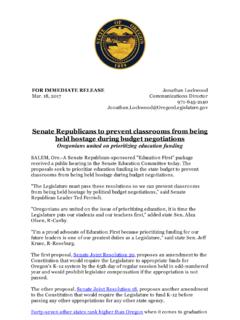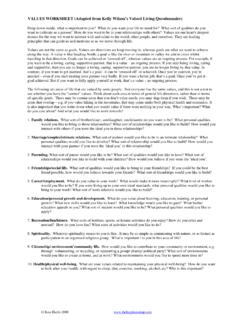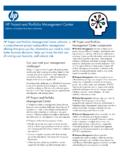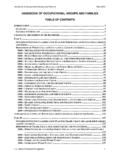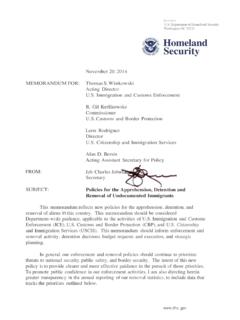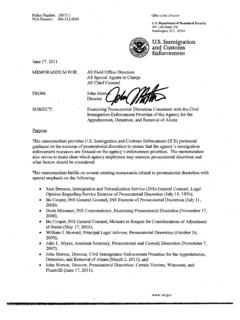Transcription of WHO/IVB/14.05 IMMUNIZATION SUPPLY CHAIN …
1 WHO/ IMMUNIZATION SUPPLY CHAIN . AND logistics . a n e g l e ct e d b u t e s s e n t i a l sy s t e m fo r n at i o n a l i m m u n i z at i o n p r o g r a m m e s A CALL-TO-ACTION. fo r n at i o n a l p r o g r a m m e s a n d t h e g lo b a l c o m m u n i t y b y t h e w h o i m m u n i z at i o n p r a ct i c e s a d v i s o r y c o m m i t t e e GENEVA, SWITZERLAND MARCH 2014. w e the IMMUNIZATION Practices Advisory Committee (IPAC). members, call on national IMMUNIZATION programmes and the global community to review and renew investment in their IMMUNIZATION SUPPLY CHAIN and logistics (ISCL) systems;. otherwise, the benefits of IMMUNIZATION programmes will be jeopardized by obstacles limiting access to, and use of, effective vaccines. IM M U N IZ ATION S UPPLY CHA I N A ND LO G I ST I C S. Call-to-Action T. he IMMUNIZATION SUPPLY CHAIN and logistics (ISCL) systems, which were designed in the 1980s, have supported the achievement of acceptable vaccination coverage, using coping mechanisms to overcome enduring challenges in vaccine storage, distribution and management.
2 The dedication, intelligence and creativity of health workers acting within outdated ISCL systems have substituted for much-needed assets and capital. Despite many efforts, national IMMUNIZATION programmes, already struggling to meet the demands of routine IMMUNIZATION and supplemental campaigns, may not be in the best position to respond to the introduction of all the new vaccines. A widening variety of new vaccines and IMMUNIZATION schedules, a diversity of service delivery strategies, an expanding target population, increased cold- CHAIN infrastructure requirements and insufficient funding, are just a few of the new realities that will further stress ISCL systems, which were initially designed to manage fewer, less expensive and less bulky vaccines and related supplies. Existing systems cannot keep pace with the changing landscape of national IMMUNIZATION programmes, resulting in stock-outs, potential administration of ineffective vaccines, avoidable wastage and inadequate cold- CHAIN capacity, all of which have considerable coverage, performance and cost implications.
3 These inefficiencies not only hinder the ability to provide much-needed immunizations, they also yield a lower return in health outcomes for those investing in the research, production, procurement and delivery of vaccines, threatening the dependability of future funding sources. The growth in complexity of IMMUNIZATION programmes is occurring at the same time as the development and application of innovative SUPPLY CHAIN strategies and technology, especially in the private sector. In the public sector, national IMMUNIZATION programmes, and the global community that supports them, have an opportunity to improve their performance and a mandate to provide the right vaccines in the right quantities, in the right condition, at the right time, in the right place and at the right SUPPLY CHAIN cost. ii CA L L-TO -ACTI O N. Recommendations National IMMUNIZATION programmes Measure and monitor the health of the ISCL. system Apply the Effective Vaccine Management (EVM) Initiative tool and process to assess the state of the ISCL system, identifying strengths and weaknesses to prioritize improvements.
4 Emphasize routine programme monitoring and performance improvement. Plan and implement improvements Prepare and implement improvement plans that address system weaknesses with pragmatic responses, and introducing SUPPLY CHAIN innovations that produce increased visibility and flexibility to manage future changes in ISCL systems. Global community of partners Increase awareness and investment Call attention to the complexities of ISCL systems. Increase funding to recruit, train and incentivize people and prioritize the collection and analysis of data needed to run national IMMUNIZATION programmes. Address ISCL in IMMUNIZATION recommendations Place implementation issues and evidence of ISCL impacts into the core of IMMUNIZATION recommendations and decision-making. Harmonize ISCL systems Take purposeful advantage of new vaccination initiatives, to build upon and strengthen an integrated ISCL system across programmes.
5 Resolve knowledge gaps to accelerate learning Highlight ISCL knowledge gaps, identify what is working, create learning opportunities and accelerate the spread of proven approaches. iii The Department of IMMUNIZATION , Vaccines and Biologicals thanks the donors whose unspecified financial support has made the production of this publication possible. This document was published by the Expanded Programme on IMMUNIZATION of the Department of IMMUNIZATION , Vaccines and Biologicals. Ordering code: WHO/ Published in July 2014. This publication is available on the Internet at: Copies of this publication as well as additional materials on IMMUNIZATION , vaccines and biologicals may be requested from: World Health Organization Department of IMMUNIZATION , Vaccines and Biologicals CH-1211 Geneva 27, Switzerland Fax: + 41 22 791 4227. Email: World Health Organization 2014. All rights reserved. Publications of the World Health Organization are available on the WHO website ( ) or can be purchased from WHO Press, World Health Organization, 20 Avenue Appia, 1211 Geneva 27, Switzerland (tel.)
6 : +41 22 791 3264; fax: +41 22 791 4857; e-mail: The designations employed and the presentation of the material in this publication do not imply the expression of any opinion whatsoever on the part of the World Health Organization concerning the legal status of any country, territory, city or area or of its authorities, or concerning the delimitation of its frontiers or boundaries. Dotted lines on maps represent approximate border lines for which there may not yet be full agreement. The mention of specific companies or of certain manufacturers' products does not imply that they are endorsed or recommended by the World Health Organization in preference to others of a similar nature that are not mentioned. Errors and omissions excepted, the names of proprietary products are distinguished by initial capital letters. All reasonable precautions have been taken by the World Health Organization to verify the information contained in this publication.
7 However, the published material is being distributed without warranty of any kind, either expressed or implied. The responsibility for the interpretation and use of the material lies with the reader. In no event shall the World Health Organization be liable for damages arising from its use. The named authors alone are responsible for the views expressed in this publication. Design and layout by L'IV Com S rl, Villars-sous-Yens, Switzerland. Printed by the WHO Document Production Services, Geneva, Switzerland. TABLE OF CONTENTS. ACKNOWLEDGEMENTS.. vi ACRONYMS.. vii TERMS.. viii SUPPORTING EVIDENCE.. 1. ISCL CHALLENGES.. 1. RECOMMENDATIONS.. 4. RECOMMENDATIONS FOR NATIONAL IMMUNIZATION PROGRAMMES.. 4. 1. Measure, monitor and evaluate the health of the ISCL .. 4. 2. Plan and implement improvements.. 5. RECOMMENDATIONS FOR THE GLOBAL COMMUNITY OF PARTNERS.. 8. 1. Increase awareness and investment.. 8. 2. Address ISCL when formulating IMMUNIZATION recommendations.
8 9. 3. Harmonize ISCL .. 9. 4. Identify and resolve knowledge gaps to accelerate learning and spread solutions.. 10. ENDORSEMENT.. 11. REFERENCES.. 12. v IM M U N IZ ATION S UPPLY CHA I N A ND LO G I ST I C S. ACKNOWLEDGEMENTS. This document was endorsed by the IMMUNIZATION Practices Advisory Committee of the World Health Organization in March 2014. The committee thanks the expert working group for their key contributions in the development of this publication: Robin Biellik, Xavier Bosch-Capblanch, Shelley Deeks, Chris Morgan, Jean- Marc Oliv , and Robert Steinglass. Gratitude is also expressed to the following for facilitation in research and drafting: Osman Mansoor (UNICEF), Ryan McWhorter (WHO consultant), Patrick Lydon (WHO), and Diana Chang-Blanc (WHO). vi CA L L-TO -ACTI O N. ACRONYMS. EVM Effective Vaccine Management HIV human immunodeficiency virus HSS health systems strengthening IPAC IMMUNIZATION Practices Advisory Committee ISCL IMMUNIZATION SUPPLY CHAIN and logistics KPI key performance indicator LMIS logistics Management Information System MDVP multi-dose vial policy UNICEF United Nations Children's Fund USAID United States Agency for International Development VMI vendor managed inventory VVM vaccine vial monitor WHO World Health Organization vii IMMUNIZ ATION S UPP LY C H A I N A ND LO G I ST I C S.
9 TERMS. Avoidable wastage Also known as unopened vial wastage, vaccine wastage due to being lost, stolen, broken, expired, or any other cause to make the vaccine unusable prior to being opened. Cold- CHAIN capacity The total volume of functional temperature-controlled storage, including refrigerators, cold rooms, carriers or other temperature-controlled storage equipment. Cold- CHAIN inventory A record of the quantities and types of temperature-controlled storage and transport equipment, including refrigerators, freezers, cold rooms, cold boxes and vaccine carriers. Direct delivery The movement of inventory directly from a vendor to a buyer. Also, the movement of inventory directly from a national storage warehouse to a district warehouse or health facility. IMMUNIZATION SUPPLY CHAIN The people, data, assets and processes that manage the data collection, forecasting, and logistics system ordering, distribution, storage and delivery of vaccines and other supplies.
10 Inventory holding point A location where inventory is stored, which could be a warehouse, a health facility or transport equipment. Inventory service level A measurement of the performance of inventory replenishment policies, taking into consideration the amount of safety stock, the speed of use and the number of stock- outs. Order response time The amount of time between a product being ordered (requested) and the product arriving at the destination. Stock-out When a product is not available. Third party logistics A firm that provides outsourced (or "third party") logistics services for part, or all, of provider the SUPPLY CHAIN management functions. Transportation sourcing The process of establishing a contractual relationship with transportation providers. Vaccine availability A measurement of the amount of time that a vaccine is available for shipment from a warehouse, or is available for use at a health facility.











